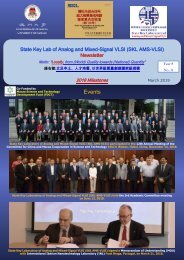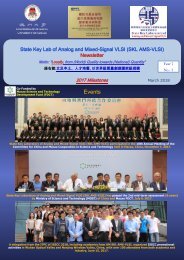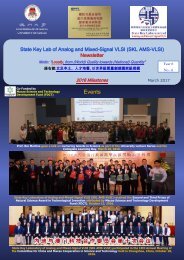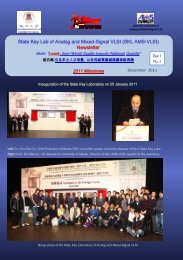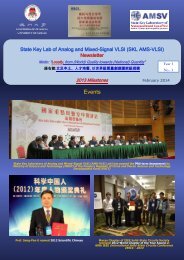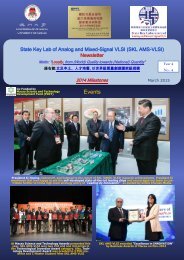AMSV Newsletter 2015
AMSV Newsletter 2015
AMSV Newsletter 2015
Create successful ePaper yourself
Turn your PDF publications into a flip-book with our unique Google optimized e-Paper software.
A Digital Low-Dropout Regulator with Coarse-Fine-Tuning and<br />
Burst-Mode Operation<br />
Mo Huang, Yan Lu, Sai-Weng Sin, Seng-Pan U, and Rui P. Martins<br />
In TCAS-II 2016<br />
[Accepted in <strong>2015</strong>]<br />
From Integrated Power research line<br />
Motivation<br />
Digital low-dropout (D-LDO) regulator, that replaces the<br />
power transistor in analog LDO regulator with a power<br />
switch array, has recently drawn significant attention for<br />
its low operation voltage and process scalability feature.<br />
However, for a conventional shift register based D-LDO,<br />
only one PMOS is turned on/off per clock cycle for the<br />
shift register operation; and the transient speed can only<br />
be improved by increasing sampling frequency which<br />
degrades the power consumption. To address this issue,<br />
a wide load range D-LDO regulator with coarse-fine tuning<br />
and burst-mode techniques is proposed for fast transient<br />
response and low quiescent current.<br />
Architecture<br />
For the proposed topology, the PMOS arrays consist of one<br />
coarse section and one fine section, driven by separate shift<br />
registers. To extend the load current range, the coarse<br />
PMOS array is designed to be with 64 power switches. The<br />
unit size of the coarse PMOS is designed to be 16 times of<br />
that of the fine PMOS for the loop gain boosting. To cover<br />
the current gap between two adjacent coarse bits can provide,<br />
the fine PMOS array is designed with 32 units for sufficient<br />
margin. Once the voltage undershoot/overshoot is<br />
detected, the coarse-tuning quickly finds out the coarse control<br />
word in which the load current should be located, with<br />
large power MOS strength and high sampling frequency for<br />
a fixed duration. Then, the fine-tuning with reduced power<br />
MOS strength and sampling frequency takes over the<br />
steady-state operation for high accuracy and current efficiency.<br />
Implementation<br />
Verification<br />
The proposed D-LDO regulator was fabricated in a 65-nm<br />
CMOS process.




